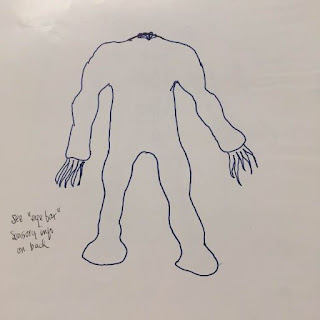While I don’t write full-time, nor do I make enough money with my writing to live off of it...neither do all of the professional writers above...someone pays for and publishes ten percent of what I write. When I started this blog, that was NOT true, so I may have reached a point where my own advice is reasonably good. We shall see! As always, your comments are welcome!
Moving plants have always fascinated me – from the Venus Flytrap (I was crushed to find out how tiny they were…and how hard they would be to keep in my native Minnesota!) to the sundew (which DOES live in Minnesota) made me wonder about moving plants, especially when all the movies and pictures I saw of them made them look like gigantic, monstrous creatures. I was crushed a month ago to find that native sundew was TINY – a sticky head as small as a drop of water…
Pitcher plants were amazing, though they didn’t move. The idea of a wide open mouth inviting insects in, and then having them climb in and fall or slide down the open throat and into a puddle of enzymes that would slowly dissolve them away – was vaguely creepy, but really cool!
Finally, my heart set on the mobile flagellated algae (sounds like plants that perform penance by whipping themselves)…but they were all microscopic. Several years later, I turned my mind and a fairly newly minted biology degree to create an intelligent alien that was made of an amalgam of all of the properties of these species. What if life on Earth had evolved from flagellated algae instead of a maximalistic choanozoan ancestor?
Intelligent plants might have been the result.
I created the WheetAh (whom I’ve mentioned before on my regular blog, here if you’re interested. Just search for WheetAh) years ago and have had a story about them published. In it, I had Human teens and WheetAh “teens” on a boat doing a publicity stunt that might or might not build Human-WheetAh relations (which are strained at this point, maybe on the verge of war). They solve a murder by working together along with both sympathetic and antagonistic adults…
So, they behaved like inexperienced young intelligences. Do they learn the same way? No, but that never came up. Did they learn the same thing…hmmm…cooperation solves problems. While all adults know this to be true, they’ve found it to NOT be true enough times that they doubt it can work in “the real world”.
But, kids don’t know that. They haven’t had the “real world” knock them down often enough – at least not kids who grow up in a supportive environment where there are others who care about both what they know and what they need do know. Among Humans this is a difficult enough learning experience – how do plants learn? Can plants be “trained” even? Apparently the answer is a tentative “yes” – at least in reference to plants on Earth. You can listen to the podcast here – it’s in two parts: https://www.castofwonders.org/2011/12/episode-20-peanut-butter-and-jellyfish-part-1-by-guy-stewart/ and https://www.castofwonders.org/2011/12/episode-21-peanut-butter-and-jellyfish-part-2-by-guy-stewart/
I postulated that a plant-animal that evolved from the flagellates I mentioned above would look like this:
These are the WheetAh I’m talking about. I’m no artist, but you can see the basic design, and I’ll add they “walk” by spinning (like the Masters in John White’s TRIPOD books). So, I’ll take that as a confirmation that it’s possible. My big problem STILL remains how would intelligent plantimals (I need another word, apparently “plantimal” is used in some sort of video game.) Maybe Kleptees* (instead of EeTees)…
How do plants ACT? Hmmm…let’s start out with what they “are” first.
WHAT are plants?
How do plants ACT? Hmmm…let’s start out with what they “are” first.
WHAT are plants?
-single cell or multicellular organisms
-they make their own food (photosynthetic and contain a green pigment called chlorophyll, which enables plants to convert energy from the sun into food
-store their food as starch
-rooted to one place (some can orientate leaves towards the sun; some respond to touch)
-cell walls are rigid as they’re made of cellulose.
-life cycle of plants includes both a sporophyte and a gametophyte, ‘alternation of generations'
-lack central nervous system
How they act?
-anticipate future conditions by accurately perceiving and responding to reliable environmental cues
-exhibit memory
-alter behaviors depending upon experiences
-communicate with other plants, herbivores and mutualists
-emit cues causing predictable reactions in other organisms
-respond to cues
-adapt to spatially and temporally heterogeneous environments
-evolved plastic response systems
So – do plants act like Humans in funny green suits? They SHOULDN’T…yet, I may have made them do just that. So, I have work to do as I think this all through…
Expect more about the WheetAh as I continue to grow them (no pun intended) into the ALIEN ALIENS they are and as I develop them into more alien aliens.
-------------------------------------------------------
* Kleptees instead of E.T. or ETee or EeTee or
* Kleptees instead of E.T. or ETee or EeTee or
Middle Dutch cleppe (“rattle used by lepers”); klep f (plural kleppen, diminutive klepje n) English = hatch, visor, valve, (slang) mouth; (obsolete) a rattle used by lepers to alert others of their presence
Indonesian: klep
Indonesian: klep
Papiamentu: klèp
Etymology 2: Verb; From Dutch klep, from Middle Dutch cleppe (“rattle used by lepers”): klep (first-person possessive klepku, second-person possessive klepmu, third-person possessive klepnya) (English = valve); Polish; Pronunciation Verb: klep, second-person singular imperative of klepać; English; “clap”
Image: My own
Etymology 2: Verb; From Dutch klep, from Middle Dutch cleppe (“rattle used by lepers”): klep (first-person possessive klepku, second-person possessive klepmu, third-person possessive klepnya) (English = valve); Polish; Pronunciation Verb: klep, second-person singular imperative of klepać; English; “clap”
Image: My own

















0 comments:
Post a Comment